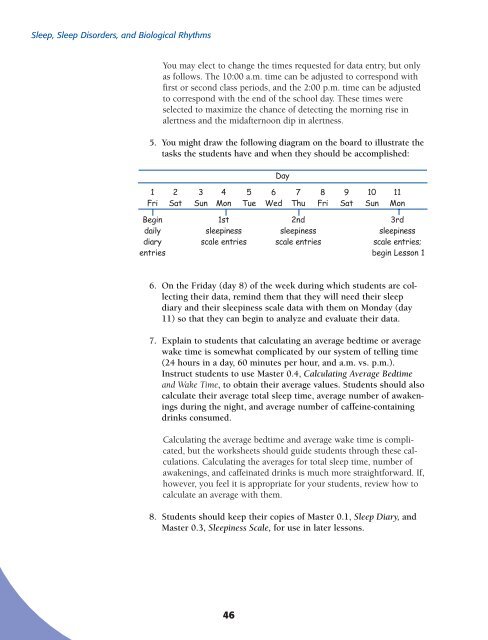Biological - NIH Office of Science Education - National Institutes of ...
Biological - NIH Office of Science Education - National Institutes of ...
Biological - NIH Office of Science Education - National Institutes of ...
Create successful ePaper yourself
Turn your PDF publications into a flip-book with our unique Google optimized e-Paper software.
Sleep, Sleep Disorders, and <strong>Biological</strong> Rhythms<br />
You may elect to change the times requested for data entry, but only<br />
as follows. The 10:00 a.m. time can be adjusted to correspond with<br />
first or second class periods, and the 2:00 p.m. time can be adjusted<br />
to correspond with the end <strong>of</strong> the school day. These times were<br />
selected to maximize the chance <strong>of</strong> detecting the morning rise in<br />
alertness and the midafternoon dip in alertness.<br />
5. You might draw the following diagram on the board to illustrate the<br />
tasks the students have and when they should be accomplished:<br />
Day<br />
1 2 3 4 5 6 7 8 9 10 11<br />
Fri Sat Sun Mon Tue Wed Thu Fri Sat Sun Mon<br />
Begin 1st 2nd 3rd<br />
daily sleepiness sleepiness sleepiness<br />
diary scale entries scale entries scale entries;<br />
entries begin Lesson 1<br />
6. On the Friday (day 8) <strong>of</strong> the week during which students are collecting<br />
their data, remind them that they will need their sleep<br />
diary and their sleepiness scale data with them on Monday (day<br />
11) so that they can begin to analyze and evaluate their data.<br />
7. Explain to students that calculating an average bedtime or average<br />
wake time is somewhat complicated by our system <strong>of</strong> telling time<br />
(24 hours in a day, 60 minutes per hour, and a.m. vs. p.m.).<br />
Instruct students to use Master 0.4, Calculating Average Bedtime<br />
and Wake Time, to obtain their average values. Students should also<br />
calculate their average total sleep time, average number <strong>of</strong> awakenings<br />
during the night, and average number <strong>of</strong> caffeine-containing<br />
drinks consumed.<br />
Calculating the average bedtime and average wake time is complicated,<br />
but the worksheets should guide students through these calculations.<br />
Calculating the averages for total sleep time, number <strong>of</strong><br />
awakenings, and caffeinated drinks is much more straightforward. If,<br />
however, you feel it is appropriate for your students, review how to<br />
calculate an average with them.<br />
8. Students should keep their copies <strong>of</strong> Master 0.1, Sleep Diary, and<br />
Master 0.3, Sleepiness Scale, for use in later lessons.<br />
46

















